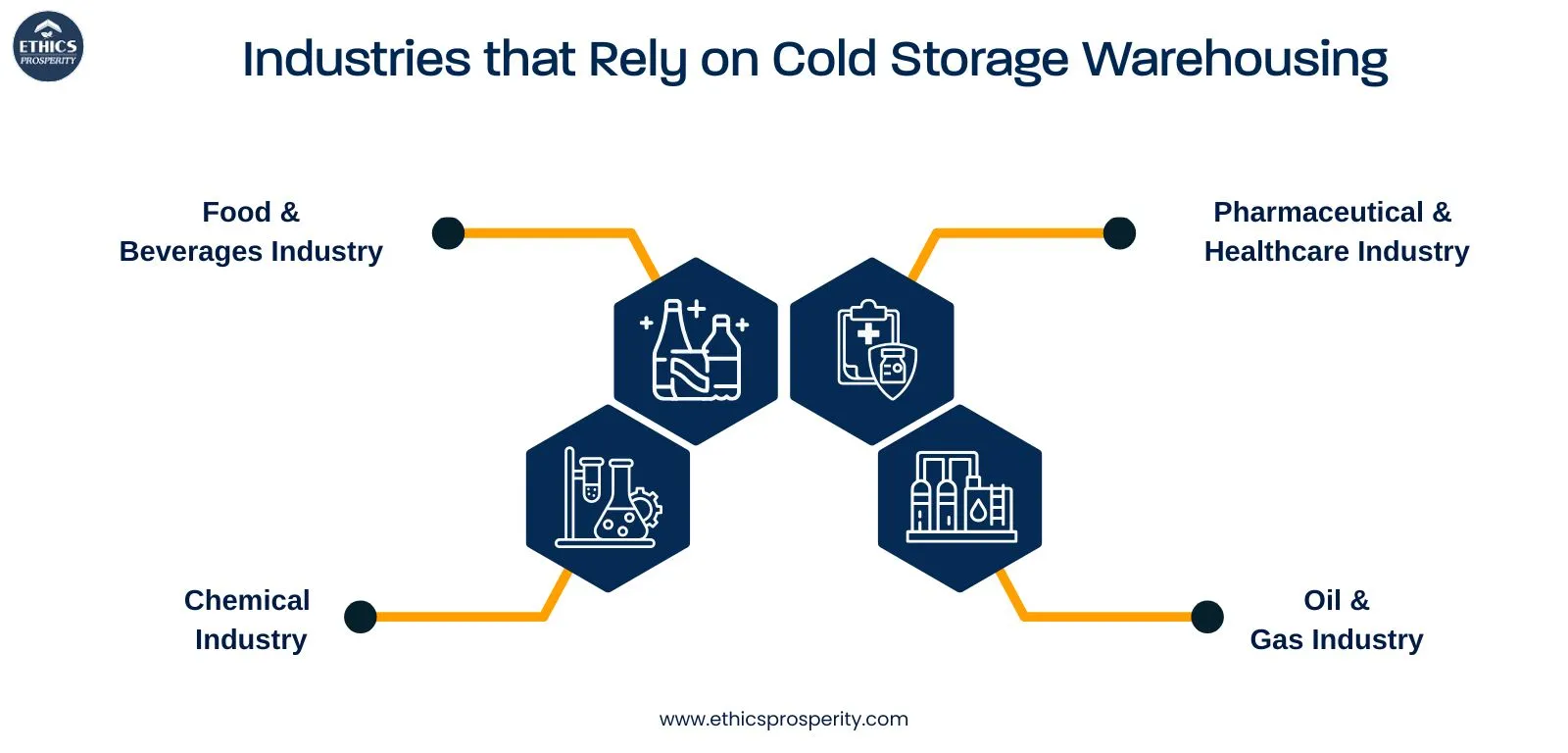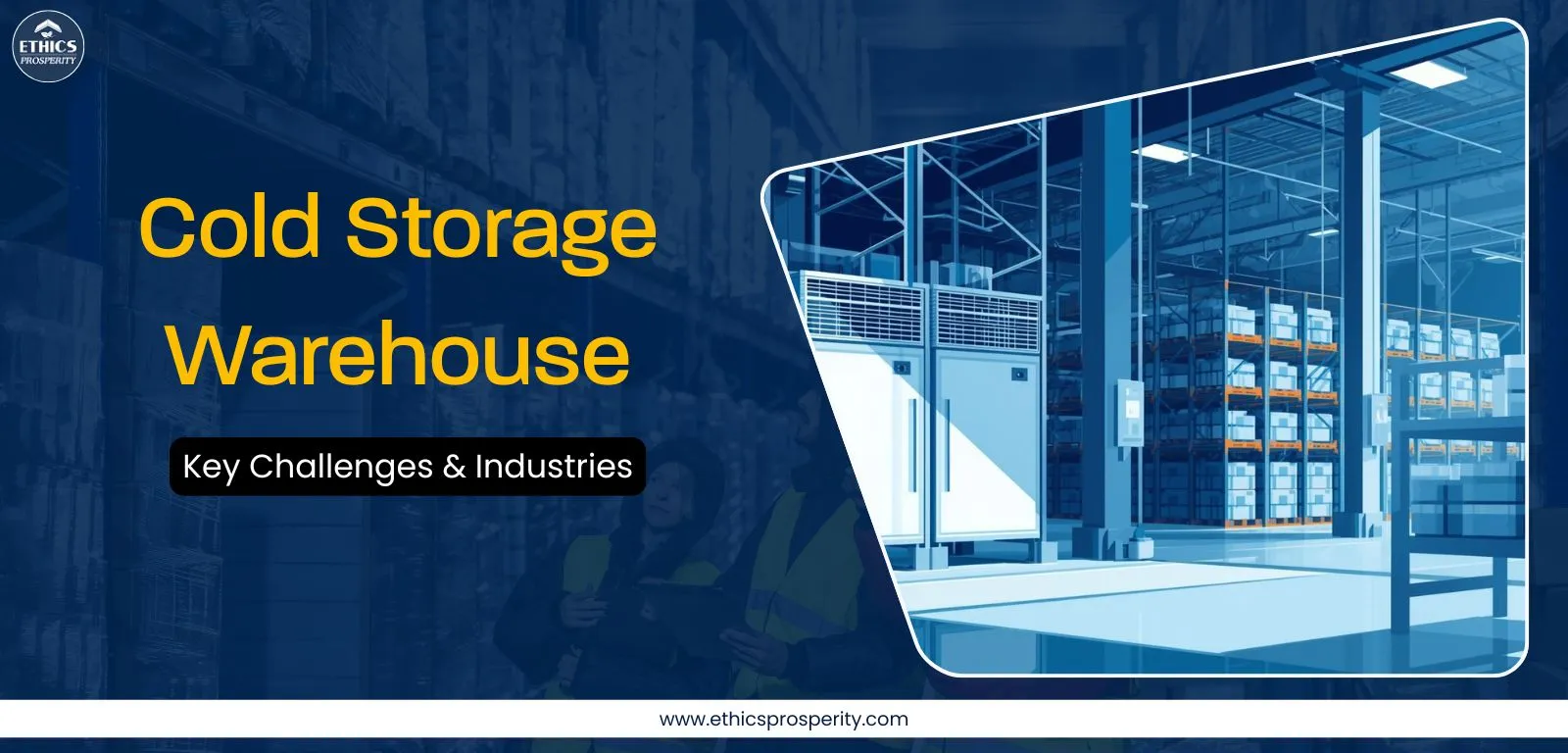Cold storage warehousing refers to a specialized type of cold storage facility designed to maintain controlled temperature environments for goods that are sensitive to heat or spoilage. Unlike conventional warehouses, these facilities utilize advanced refrigeration technology and tailored infrastructure to sustain precise temperature levels. This ensures that perishable products—such as food items, pharmaceuticals, and flowers—remain fresh and safe for longer periods. Thus, Effective temperature management is essential in these warehouses, as even small variations can cause deterioration or spoilage of stored goods.
Its two main logistics, which ensure a seamless, efficient flow of perishable goods while minimizing spoilage and meeting food safety standards, are as follows:
-
Inbound Logistics: It involves receiving goods from suppliers or production sites, inspecting quality, recording inventory, and quickly transferring items into refrigerated or frozen zones to preserve freshness.
-
Outbound Logistics: It focuses on order picking, packing, and loading products into temperature-controlled vehicles for distribution to retailers, restaurants, or consumers. It emphasizes timely delivery, temperature integrity, and traceability.
Key Challenges to Cold Storage Warehousing
-
High Energy Demand:
In Cold Chain Logistics, one of the major challenges is due to their high energy demand as maintaining low temperatures requires continuous operation of refrigeration systems, which consume large amounts of electricity. Thus, poor insulation, frequent door openings, and outdated equipment can further increase power usage and costs.
-
Product Tracking:
Product tracking in a cold storage warehouse is difficult because low temperatures can affect barcode and RFID performance, and condensation may damage labels.
Workers’ limited time in cold areas can also lead to scanning errors and misplaced items. Thus, maintaining real-time visibility is challenging, so many facilities now use durable RFID tags and automated systems to improve accuracy and traceability.
-
Temperature Control:
Maintaining stable temperatures in cold storage warehouses is challenging due to frequent door openings, uneven air circulation, and potential equipment failures and even minor fluctuations can cause product spoilage or quality loss.
Thus, High energy consumption, insulation issues, and power outages add to the difficulty and to manage these challenges, warehouses rely on advanced monitoring systems, proper insulation, regular maintenance, and backup power to ensure consistent temperature control.
-
Worker Safety:
Cold storage warehouses pose significant safety risks for workers due to the extreme temperatures as prolonged exposure to cold can lead to hypothermia, frostbite, or reduced dexterity, increasing the likelihood of accidents.
Limited visibility in some storage areas like slippery floors caused by ice or condensation, heavy lifting, and handling of machinery also contribute to workplace injuries as well as the urgency to move perishable goods quickly can further heighten risks.
Industries that Rely on Cold Storage Warehousing

Cold chain logistics are essential for many sectors to maintain the efficacy and safety of their products as to avoid spoiling and damage, these industries must adhere to strict temperature restrictions.
-
Food and Beverages Industry:
The food and beverages industry relies heavily on cold storage facilities to maintain product quality, safety, and shelf life as it provides temperature-controlled environments that slow down biological and chemical processes that cause spoilage and they preserve freshness which ensures food safety which balances demand and supply and thus, supports supply chain management.
Some of them includes custom bonded warehouses, which are government-authorized storage facilities where imported goods can be stored without immediate payment of customs duties or taxes as they are used for perishable imports like meat, seafood, dairy, and frozen foods that require strict temperature control until they’re cleared for domestic sale or re-export.
Temperature-Zoned Storage for Food and Beverage Products
|
Category |
Typical Storage Temperature |
Examples |
|
Frozen foods |
-18°C or lower |
Meat, seafood, ice cream, frozen meals |
|
Chilled foods |
0°C to 4°C |
Dairy, fresh produce, beverages |
|
Beverages |
2°C to 10°C |
Juices, soft drinks, wines, craft beers |
|
Non-Refrigerated Storage |
10°C to 20°C |
Packaged foods, dry ingredients |
-
Pharmaceutical and Healthcare Industry:
Cold storage warehousing is vital for the pharmaceutical industry, ensuring the safe, effective, and compliant storage of life-saving products. As the demand for biologics and temperature-sensitive medicines grows, advanced cold storage infrastructure and digital monitoring technologies will continue to shape the industry’s future.
As advances in transplants and surgery have increased the need for reliable cold storage because organs, tissues, and skin grafts must be kept at consistent cold temperatures to maintain their viability. Thus, Cold storage enables safe, long-distance transport of these materials, making life-saving procedures possible and improving patient outcomes.
Temperature-Zoned Storage for Pharmaceutical and Healthcare Industry
|
Storage Type |
Temperature Range |
Examples of Products |
|
Ultra-Low Freezer Storage |
-80°C to -60°C |
mRNA vaccines, cell & gene therapies |
|
Frozen Storage |
-25°C to -15°C |
Plasma, some vaccines |
|
Refrigerated Storage |
+2°C to +8°C |
Insulin, biologics, certain antibiotics |
|
Controlled Room Temperature (CRT) |
+15°C to +25°C |
Tablets, capsules, and some medical devices |
-
Chemical Industry:
The chemical industry relies on cold storage to preserve product stability and safety. Many chemicals, reagents, and solvents are temperature-sensitive and can degrade, react, or emit hazardous fumes if exposed to heat. Controlled cold warehousing ensures quality, extended shelf life, and regulatory compliance.
Storage facilities use specialized temperature zones, humidity control, and safety measures to handle corrosive or volatile materials. This is essential for pharmaceutical raw materials, industrial chemicals, and laboratory reagents, supporting both product integrity and worker safety across the supply chain.
Temperature-Zoned Storage for Chemical Industry
|
Zone Type |
Temperature Range |
Typical Stored Materials |
|
Deep Freeze Storage |
-80°C to -20°C |
Biological samples, specialty chemicals, enzymes |
|
Refrigerated Storage |
+2°C to +8°C |
Reactive chemicals, certain solvents, and pharmaceutical intermediates |
|
Cool Storage |
+8°C to +15°C |
Laboratory reagents, adhesives, polymers |
|
Controlled Room Temperature (CRT) |
+15°C to +25°C |
General chemicals, dry powders, non-reactive materials |
|
Non-Refrigerated Storage |
+25°C to +30°C |
Stable industrial chemicals and packaged goods |
-
Oil and Gas Industry:
In the oil and gas sector, cold storage facilities are essential for preserving temperature-sensitive materials used in exploration, refining, and maintenance. Certain chemical additives, catalysts, lubricants, and samples require controlled temperatures to prevent degradation and maintain performance.
By maintaining consistent cold conditions, these facilities help the industry extend material shelf life, reduce waste, and ensure reliability in harsh or remote operating environments.
Temperature-Zoned Storage for Oil and Gas Industry
|
Storage Zone |
Temperature Range |
Common Applications / Materials |
|
Deep Freeze Storage |
-80°C to -20°C |
Core samples, biological or environmental test samples |
|
Refrigerated Storage |
+2°C to +8°C |
Chemical additives, corrosion inhibitors, and drilling mud samples |
|
Cool Storage |
+8°C to +15°C |
Specialized lubricants, catalysts, polymer-based materials |
|
Controlled Room Temperature (CRT) |
+15°C to +25°C |
Stable chemicals, lab reagents, refined samples |
|
Non-Refrigerated Storage |
+25°C to +30°C |
General equipment, packaged goods, maintenance materials |
Future Trends in Cold Storage Warehousing
The cold storage industry is evolving rapidly with advancements in technology, sustainability, automation, and the emergence of smart warehouses that integrate IoT, AI, and data-driven systems to enhance efficiency, reduce energy consumption, and ensure precise temperature control to meet growing global demand. Key future trends include:
-
Automation and Robotics:
One of the most significant advancements in cold storage is the growing use of automation and robotics. These technologies streamline operations, enhance efficiency, and improve safety in environments where manual work is challenging due to extreme temperatures. By automating material handling and inventory processes, facilities achieve greater accuracy, speed, and reliability while reducing labor risks and operational costs.
-
Automated Guided Vehicles (AGVs), autonomous forklifts, and robotic palletizers reduce human exposure to cold temperatures while handling goods faster and more precisely.
-
Automated storage and retrieval systems (AS/RS) optimize space utilization and minimize energy loss by limiting door openings and human movement.
-
IOT and Real-Time Monitoring:
The adoption of IoT technology is transforming cold storage operations by offering continuous, real-time visibility into temperature, humidity, and system performance. Connected sensors send instant alerts when conditions deviate, helping maintain product quality and reduce losses.
By leveraging cloud-based data and analytics, operators can monitor, manage, and optimize facilities remotely. This improves efficiency, compliance, and traceability, positioning IoT as a vital tool for the future of smart, reliable cold storage management.
-
Warehouse Management Systems:
Warehouse Management Systems (WMS) are becoming a key trend in modern cold storage facilities by improving efficiency, accuracy, and visibility. These systems enable real-time tracking of inventory, optimize storage space, and streamline order processing even in challenging low-temperature environments.
Thus, this technology helps reduce waste, enhance productivity, and maintain strict quality standards essential in temperature-sensitive supply chains.
-
Last-Mile Deliveries:
The surge in e-commerce, online groceries, and meal kits has made last-mile delivery a critical part of the cold chain. It ensures that perishable and frozen goods reach customers quickly while maintaining strict temperature control.
To achieve this, companies are adopting refrigerated transport, localized cold storage hubs, and real-time temperature monitoring. These innovations help reduce spoilage, maintain product freshness, and meet rising consumer expectations for speed, quality, and reliability in cold deliveries.
Conclusion
Cold Storage Warehousing plays a vital role in preserving the quality, safety, and effectiveness of temperature-sensitive products; therefore, businesses ensure products remain stable and compliant from production to delivery, maintaining integrity throughout the entire end-to-end supply chain.
The cold storage industry is undergoing a major transformation driven by rising demand, technological advancements, and economic shifts. Thus, changing consumer habits, the push for automation, and a focus on sustainability and energy efficiency are reshaping operations across all sectors.
